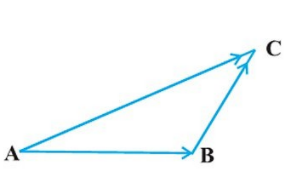If C is the mid point of AB and P is any point outside AB then (A) −−→PA+−−→PB+−−→PC=0 (B) −−→PA+−−→PB+2−−→PC=→0 (C) −−→PA+−−→PB=−−→PC (D) −−→PA+−−→PB=2−−→PC
P→A+P→B+P→C=→0
P→A+P→B+2P→C=→0
P→A+P→B=P→C
P→A+P→B=2P→C
The correct Answer is:D
To solve the problem, we need to analyze the vectors involved and their relationships based on the given conditions. Let's denote the points as follows:
- Let A and B be two points in space.
- Let C be the midpoint of segment AB.
- Let P be a point outside the line segment AB.
We need to find the correct relationship among the vectors →PA, →PB, and →PC.
1. Identify the Midpoint:
Since C is the midpoint of AB, we can express the position vector of C as:
→C=→A+→B2
2. Express the Vectors:
The vectors from point P to points A, B, and C can be expressed as:
→PA=→A−→P
→PB=→B−→P
→PC=→C−→P
3. Using Triangle Law of Addition:
In triangle PAC:
→PA+→AC=→PC
Here, →AC=→C−→A.
Substituting for →C:
→AC=(→A+→B2)−→A=→B−→A2
Thus, we have:
→PA+→B−→A2=→PC
4. In triangle PBC:
Similarly, we can write:
→PB+→BC=→PC
Where →BC=→C−→B:
→BC=(→A+→B2)−→B=→A−→B2
Thus:
→PB+→A−→B2=→PC
5. Combining the Equations:
Now, we can combine both equations:
→PA+→B−→A2+→PB+→A−→B2=2→PC
Simplifying this, we find:
→PA+→PB+→B−→A+→A−→B2=2→PC
The terms →B−→A and →A−→B cancel each other out, leading to:
→PA+→PB=2→PC
Conclusion:
Thus, the correct relationship is:
→PA+→PB=2→PC
The answer is option (D).
- Let C be the midpoint of segment AB.
- Let P be a point outside the line segment AB.
Since C is the midpoint of AB, we can express the position vector of C as:
→C=→A+→B2
The vectors from point P to points A, B, and C can be expressed as:
→PA=→A−→P
→PB=→B−→P
→PC=→C−→P
In triangle PAC:
→PA+→AC=→PC
Here, →AC=→C−→A.
→AC=(→A+→B2)−→A=→B−→A2
Thus, we have:
→PA+→B−→A2=→PC
Similarly, we can write:
→PB+→BC=→PC
Where →BC=→C−→B:
→BC=(→A+→B2)−→B=→A−→B2
Thus:
→PB+→A−→B2=→PC
Now, we can combine both equations:
→PA+→B−→A2+→PB+→A−→B2=2→PC
Simplifying this, we find:
→PA+→PB+→B−→A+→A−→B2=2→PC
The terms →B−→A and →A−→B cancel each other out, leading to:
→PA+→PB=2→PC
Thus, the correct relationship is:
→PA+→PB=2→PC
The answer is option (D).
Topper's Solved these Questions
- ALGEBRA OF VECTORSBOOK - OBJECTIVE RD SHARMA ENGLISHCHAPTER - ALGEBRA OF VECTORSEXERCISE - Exercise
30 Videos
- ALGEBRA OF VECTORSBOOK - OBJECTIVE RD SHARMA ENGLISHCHAPTER - ALGEBRA OF VECTORSEXERCISE - Chapter Test
30 Videos
- ALGEBRAIC INEQUATIONSBOOK - OBJECTIVE RD SHARMA ENGLISHCHAPTER - ALGEBRAIC INEQUATIONSEXERCISE - Exercise
39 Videos
Similar Questions
Knowledge Check
If [2→a−3→b→c→d]=λ[→a→c→d]+μ[→b→c→d], then 2λ+3μ=
A13B−5C7Dnone of theseIf →a,→b and →c are unit vectors such that→a+→b+→c=0, then the values of →a.→b+→b.→c+→c.→a is
A1B32C−32Dnone of these
Prove that →a.{(→b+→c)×(→a+2→b+3→c)}=[→a→b→c].
View SolutionIf →A+→B=→C, and ∣∣→A∣∣=2∣∣→B∣∣ and →B.→C=0, then
View SolutionIf →a+→b+→c=0 and|→a|=3,∣∣→b∣∣=5,|→c|=7, then find the value of →a⋅→b+→b⋅→c+→c⋅→a.
View SolutionIf the position vector of these points are →a−2→b+3→c,2→a+3→b−4→c,−7→b+10→c, then the three points are
View SolutionThree vector →A,→B, →C satisfy the relation →A⋅→B=0and →A.→C=0. The vector →A is parallel to
View SolutionThree vector →A,→B, →C satisfy the relation →A⋅→B=0and →A.→C=0. The vector →A is parallel to
View Solution

